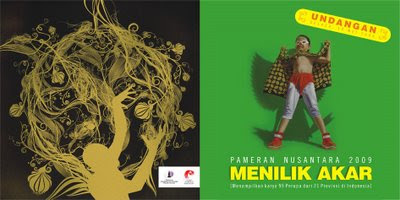Roots, identity, modernity

By Anissa S. Febrina,
The Jakarta Post, Jakarta, Thu, 05/28/2009, Arts & Design
Trying to define Indonesian modern art is probably as difficult as summing up an array of things in one word. Looking at the elements used to construct it might help, a current exhibition suggests.
Almost 100 artists, representing the country’s 21 provinces, have their say on what roots and identity mean for the future of Indonesian visual art, in the Nusantara Art Exhibition at the National Gallery.
Held since 2001, the biennale, which aims to represent artists from all over Indonesia, is all about tracing roots. If the phrase “Indonesian modern art” tends to generalize the richness that one can find the term encapsulates, then looking at the roots of that art might prove a worthwhile exercise.
“One of the most important things that people of a nation have is the imagination of a shared life and identity,” curator Kuss Indarto said.
“But individual experience highly affects the formation of a community’s collective memory and its sociocultural orientation. Thus, a collective image invented by the state feels like a fait accompli, a forced identity.”
It is indeed difficult to grasp what that collective image might be. The red and white flag? The mythical Garuda? The dominant Javanese culture?
According to Indarto, the artists participating in the exhibition have recreated traditional elements into a form that no longer physically represents the traditional, while still containing its substance.
This demonstrates artistic potential to shape new values with a richer perspective.
Ali Rubin’s A White Key for the Oppressed Indonesian Generation, and Khrisna S. Tjitrosoemarto’s In Balance video art are among the cutting edge works in this exhibition.
However, the exhibition also features works that are yet to demonstrate the dynamics of the recreation process. Some appear to be stuck in seeing and representing tradition as it is, using clichéd symbols of the traditional, without translating it into a current context. Then again, perhaps it is this diversity that defines Indonesian modern art.
There is a third line of works at the exhibition that tends to deal more with the issue of tracing roots, positioning Indonesian elements against foreign influences.
Consider Get Out! by Irawan Banuaji, which portrays a Javanese man trying to topple a giant mug bearing the image of Uncle Sam, or Saviour by I Kadek Agus Ardika, which meddles with well-known images, such as The Joker.
Globalization is indeed an issue raised by the exhibition, and it is generally a theme most artists easily respond to. The key lies in which responses had the clearest and wittiest message.
With more than 600 submissions, curators admit the selection process was tough, made even more so by the challenge of selecting a range of works from across Indonesia. Centrality, however, rules artists from Java and Yogyakarta dominate the exhibition.
Yogyakarta is home to the well-established Indonesian Art Institute Yogyakarta (ISI-Yogyakarta), which has nurtured both seasoned and emerging artists. The city is also well known for having a lively art scene of both visual and performance artists.
Another problem with having to represent all of Indonesia is the tendency to lower the bar. As a result, aesthetically speaking, some works seem to lag behind others.
Once again, that diversity is part of Indonesian modern art. All the oil and acrylic paintings and art installations speak a narrative in turn. No single piece is more prominent than any other.
After all, this exhibition is intended to be a place where both established and emerging artists share references. This is part of increasing aesthetic sensibility, Indarto said.
“If success were measured by whether new art celebrities emerged from the event, this exhibition would enter the competition,” he said. “Celebrity and commodity are important, but both are irrelevant in an aesthetic and cultural transaction.”


